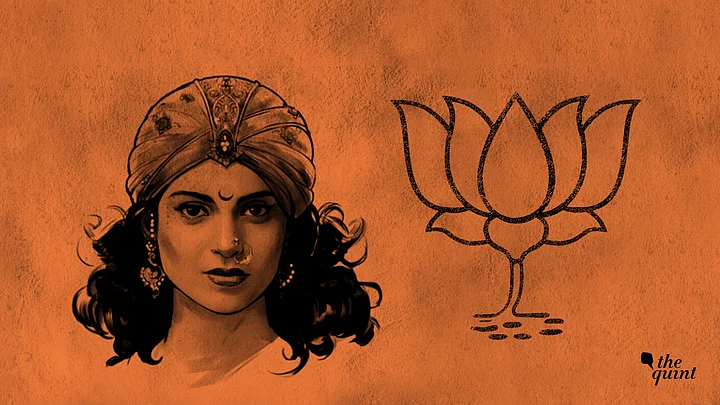For most of us, ‘Manikarnika’ is the name of the most famous burning ghat on the banks of the river Ganga in Varanasi. The eponymous film reminds us that this was the name given at birth to the person known to the world as Jhansi ki Rani Laxmibai.
She is one of the most inspiring and iconic figures in the history of India’s freedom struggle against the British.
The legendary queen took up arms against foreign intruders, and led a fierce band of loyal soldiers forging a ‘United Front’ with other rebels referred to as ‘mutineers’ by the British. Netaji Subhash Chandra Bose honoured her memory by forming a regiment named after her in the Azad Hind Fauj.
In Memory Of Rani Laxmibai
Subhadra Kumari Chauhan’s emotionally-charged poem with stirring lines like “Khoob Ladi Mardani wo to Jhansi Wali Rani Thi! Chamak Uthi Sun Sattavan Mein Wah Talwar Purani Thi” – has arguably done more than anything else to sustain her living presence, more than 150 years after her death.
A Hindi novel written by Vrindavan Lal Varma has gilded her aura. Plays, TV serials and comics have commemorated her. Academic monographs have tried over the years to separate legend and lore from history.
An aptly titled research paper ‘Gender, History and Fable’, published by Cambridge University Press, comes closest to demystifying this larger-than-life icon in the pantheon of patriotic martyrs.
And now comes Manikarnika the film, produced, directed and enacted by the talented, fiery and always controversial Kangana Ranaut. Perhaps it’s not impertinent or irrelevant to ask ‘Why now?’
Will the Likes of ‘Manikarnika’ Affect Votes in Hindi Heartland?
Another recent biopic The Accidental Prime Minister has raised the hackles of Congress party supporters, who have alleged that the film is in poor taste, and a part of the BJP’s 2019 Lok Sabha election campaign. It seems directors and producers have sensed this is open season for biopics.
A distinction must be made between films that are works of credible filmmakers and are artistically motivated, and ‘quickies’ undertaken as command performances, however cleverly disguised for strategic use in electoral battles.
Ketan Mehta’s Patel and Mangal Pandey, Attenborough’s Gandhi can be mentioned in the same breath as say Jodha-Akbar.
The dilemma of striking a balance between fact and fiction is always there. The auteurs may claim poetic license or the artistic right to an imaginative interpretation of the past, but political partisans seldom respond sympathetically.
Recall the unsavoury controversy triggered by Deepika Padukone starrer Padmaavat. And, that was about a quasi-mythical character. But we write these lines fearing for our life and limb. ‘Distinguished’ scientists, unfortunately for us, have declared that the Ramayana and Mahabharata aren’t mythology but history.
But Jhansi ki Rani is without doubt a historical character, loved and respected by millions. The hazards that exist in portraying her are obvious. Besides asking why a film on her now, one may ask this as well, “How is the person once referred to as Joan of Arc going to be depicted? And how, if at all, is this film going to impact voters’ behaviour in the Hindi heartland and Maharashtra?
An Overtly ‘Glamourous’ ‘Manikarnika’
Now, coming back to the film. Kangana looks the part. But one problem I have with the film is the injection of glamour and use of exaggeration to depict spectacular scenes. It seems like a blend of Mughal-e-Azam and Baahubali.
The fort of Jhansi perched atop a low hillock is not anything like the majestic buildings at Fatehpur Sikri, Agra or Delhi. The special effects are well-crafted, but after Baahubali and the Netflix series Mirzapur, they leave the viewer with a strong sense of déjà vu. The lyrics are well-written and the music does justice to them, but it is not likely to erase the shared memory of Subhadra Kumari Chauhan’s poem.
The Marathas worship Shiva and perhaps it is carrying secular fanaticism too far to show the Rani charging at the Firangi redcoats with the battle cry of – ‘Har Har Mahadev’. But it is more than a bit jarring when she yells out ‘Azadi’, with her sword drawn.
The rugged, undulating arid wasteland of Bundelkhand is a long distance away from the Valley gripped by unrest, where this word (allegedly loaded with sedition) is chanted rhythmically as a slogan.
BJP’s Appropriation of Historical Figures
We live in what the Chinese say, in ‘interesting times’. Freedom of expression, never really unfettered in post-Independence India, is under stress. Tolerance of dissent is low, and no one can predict how the ‘fringe’ will react to a film, book or cartoon. Manikarnika plays it safe it seems, by titling the film obliquely.
This film, like The Accidental Prime Minster, is likely to benefit the BJP, party supporters allege. The party has been accused of appropriating heroes and heroines of India’s freedom struggle to boost its campaign.
From towering statues to films, everything we are today is a part of a diabolical strategy. This, we feel, is unfair to the film. As the old Hindi saying goes, “Mole kart talwar ka parha rah do Mayan!” This can be loosely but not inaccurately translated as, “Don’t judge or evaluate the sharpness of a sword by a look at the scabbard!”
(Padma Shri awardee Professor Pushpesh Pant is a noted Indian academic, food critic and historian. He tweets @PushpeshPant. This is an opinion piece. The views expressed are the author’s own. The Quint neither endorses nor is responsible for them.)
(At The Quint, we question everything. Play an active role in shaping our journalism by becoming a member today.)
